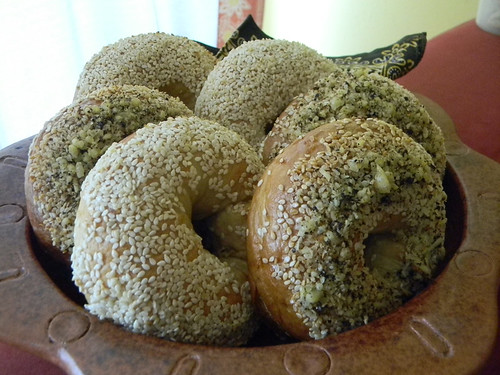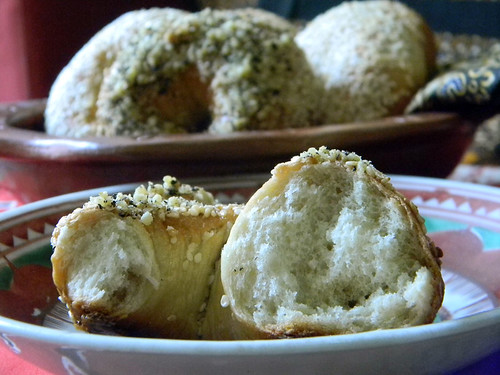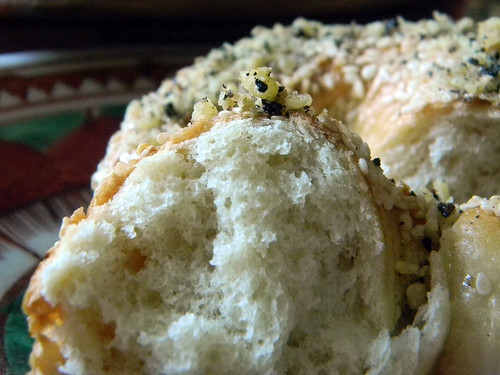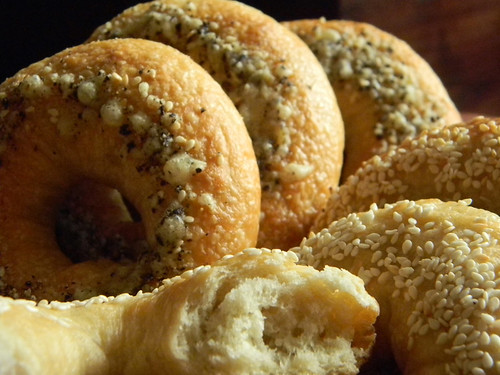
 |
| Sesame Bagels and Sesame Parmesan Black Pepper Bagels |
 |
| Yummy Sesame Parmesan Black Pepper Bagels |
 |
| Nice moist flavorful crumb and slightly chewy crust |
For the second batch, I put the bagels in the fridge for the same long fermentation right after kneading and before being shaped, then shape the bagels after, let it rise for another 60 minutes before poaching them. For the second poaching liquid, I add honey according to the recipe and cut back the poaching time half to 60 seconds in total for each bagel.
I think I prefer shaping the bagels after being slowly raised in the fridge, instead of shaping them before being put inside the fridge for the fermentation. Like this, the shape would be better, and there is less chance to over-proof the dough.
 |
| First batch bagels |
 |
| Second batch bagels |
Artisan Bagels with Sesame, Parmesan, and Black Pepper
(The recipe for this challenge was taken from Peter Reinhart's book "Artisan Breads Every Day: Fast and Easy Recipes for World-Class Breads")
Makes 6-8 bagels
Dough
1 tbsp. (21 g) barley malt syrup,
honey, or rice syrup,
or 1 teaspoon (7 g) diastatic malt
powder
1 tsp. (3 g) instant yeast
1½ tsp. (10 g) salt, or 2½ tsp.
coarse kosher salt
1 cup + 2 tbsp. (255 g) lukewarm
water (about 95°F or 35°C)
3½ cups (454 g) unbleached bread
flour
Poaching
Liquid
2 - 3 quarts (1.89 – 2.84 liter)
water
1½ tbsp. (30 g) barley malt syrup
or honey (optional)
1 tbsp. (15 g) baking soda
1 tsp. (7 g) salt, or 1½ tsp.
coarse kosher salt
Toppings
Sesame seeds
Grated Parmesan cheese and freshly
cracked Black Pepper; mix both together and set aside.
Making
the dough :
Stir the malt syrup, yeast, and salt into the lukewarm water. Place the flour into a mixing bowl and pour
in the malt syrup mixture. If using a mixer,
use the dough hook and mix on the lowest speed
for 3 minutes. If mixing by hand, use a large, sturdy spoon and stir for about 3 minutes, until well blended. The
dough should form a stiff, coarse ball, and
the flour should be fully hydrated; stir in a little more water if needed. Let
the dough rest for 5 minutes.
Resume mixing with the dough hook
on the lowest speed for another 3 minutes or transfer to a very lightly floured
work surface and knead by hand for about 10 minutes to smooth out the dough and
develop the gluten. The dough should be stiff yet supple, with a satiny, barely
tacky feel. If the dough seems too soft or overly tacky, mix or knead in a
little more flour.
Place the dough in a clean,
lightly oiled bowl, cover the bowl tightly with plastic wrap, and let the dough
rise at room temperature for 1 hour.
Shaping
the bagels :
When you’re ready to shape the bagels, prepare
a sheet pan by lining it with parchment paper or wax paper, lightly
spray or coating it with oil.
Divide the dough into 6 to 8 equal
pieces (about 100 - 113 grams). Form each piece into a loose ball by rolling it
on a clean, dry work surface with a cupped hand.
You can poke a hole through the
center of the ball to create a donut shape, holding the dough with both thumbs
in the hole, rotate the dough with your hands, gradually stretching it to
create a hole about 2 inches in diameter.
Or you can roll the ball into a
rope about 8 inches long, taper the rope slightly at each end and moisten the
last inch or so of the ends, place one end of the dough in the palm of your
hand and wrap the rope around your hand to complete the circle, going between
your thumb and forefinger and then all the way around, and the ends should
overlap by about 2 inches. Squeeze the overlapping ends together by closing
your hand, then press the seam into the work surface, rolling it back and forth
a few times to seal. Remove the dough from your hand, squeezing it to even out
the thickness if need be and creating a hole of about 2 inches in diameter.
Place each shaped bagel on the
prepared sheet pan, then mist with spray oil or brush with a light coating of
oil. Cover the entire pan with plastic wrap and refrigerate overnight or for up
to 2 days. (You can also proof the full piece of dough in the oiled bowl
overnight and then shape the bagels on baking day, 60 to 90 minutes before
boiling and baking them, or as soon as they pass the float test.)
On
baking day :
Check if
the bagels are ready for baking using the “float test”: place one of the bagels
in a small bowl of cold water. If it sinks and doesn’t float back to the
surface, shake it of, return it to the pan, and wait for another 15 to 20
minutes, then do the test again. When one bagel passes the float test, they’re
all ready to be boiled. If they pass the float test before you are ready to
boil and bake them, return them to the refrigerator so they don’t over-proof.
About 30 minutes before baking (or
right before you boil the bagels), preheat the oven to 500°F (260°C) and gather
and prepare your topings (sesame seeds and mixture of parmesan + black pepper).
Prepare also the baking tray, lined with parchment paper or silicon mat and lightly spray or coat with oil.
To make the poaching liquid, fill a pot with 2
to 3 quarts (1.8 to 2.8 liter) of water, making sure
the water is at least 10 cm (4 inches) deep. Cover, bring to a boil, then lower
the heat to maintain at a simmer. Stir in the malt syrup, baking soda, and
salt.
One by one, lift the bagel with the parchment paper underneath, lower each bagel into the simmering poaching liquid with the paper faces up, and carefully peel off the paper. They should all float to the surface within 15 seconds. After 30 seconds, use a slotted spoon to turn each bagel over. Poach for another 30 seconds. Use the slotted spoon to transfer it back to the previously prepared pan, domed side up (It’s important to lightly oil the parchment, or the paper will glue itself to the dough as the bagels bake). Sprinkle on a generous amount of sesame seeds as soon as the bagels come out of the water.
One by one, lift the bagel with the parchment paper underneath, lower each bagel into the simmering poaching liquid with the paper faces up, and carefully peel off the paper. They should all float to the surface within 15 seconds. After 30 seconds, use a slotted spoon to turn each bagel over. Poach for another 30 seconds. Use the slotted spoon to transfer it back to the previously prepared pan, domed side up (It’s important to lightly oil the parchment, or the paper will glue itself to the dough as the bagels bake). Sprinkle on a generous amount of sesame seeds as soon as the bagels come out of the water.
Transfer the pan of bagels into the preheated oven,
then lower the oven heat to 450°F (232°C). Bake for 15 minutes, rotate the pan and
check the underside of the bagels half way through. If they’re getting
too dark, place another pan under the baking sheet.
After 15 minutes, take out the tray from the oven, top
half of the bagels with the parmesan cheese and black pepper mixture, and put
the tray back in the oven, baking for another 5 minutes until the cheese is
slightly melted.
Cool on a wire rack for at least
30 minutes before slicing or serving.
My favorite is to serve bagels as sandwich,
with lettuce leaves, tomato and onion slices, cheese, and/or smoke beef slices,
on top of a little bit mustard Dijon spread.





Yippie!! asyiiik! Selamat ya. Bagelsnya kliatan keren hehehe
ReplyDeleteab